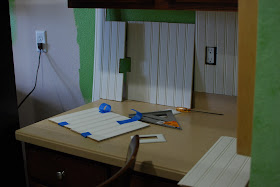I've not been sewing much this past week because I've started a new project (or 3). This definitely falls in the Home Improvement category and not in the Sewing or Knitting ones, so feel free to click away. My feelings won't be hurt. :-) However, maybe this will help someone out, so here goes...
We moved last summer to Florida, into a brand new, perfect home (yea!). It has no "backsplash" in the kitchen except for the 3" Corian counter lip thing. After painting the kitchen walls BRIGHT green, the kitchen was feeling a bit dark, and I wanted some sort of backsplash. I got the inspiration from
The Lettered Cottage, and decided white beadboard was the way to go. Hubs left 2 weeks ago (he'll be gone for work for 4 months), so I figured there's no time like the present! Here is my beadboard backsplash journey....
I used pre-primed panels that lock together. They were a very manageable size to install myself. It would have been cheaper to get a huge sheet of un-primed beadboard, but I could have never gotten it cut accurately and nailed up by myself.
First, measure the height of the backsplash area you want to cover and cut some pieces that length. I used my miter saw and needed to flip the pieces over to cut the whole way through.


It probably won't take long for you to come to an outlet. Remove the plastic cover and start marking. If your outlet will fall between two sections of board (easier to deal with), hold up a board and mark the tip and bottom of the outlet. It's always better to err on the side of too small an opening. You can always make it a bit bigger, but if you make the hole bigger than your outlet cover, you've wasted a board.

To mark the vertical edge of the outlet, you can measure or use my very unscientific method of laying down the board where it will ajoin the next one and using a straight edge to find the mark for cutting.

Here is the rectangle I need to cut out:

Using a jigsaw, cut the two lines intersecting with the edge.

Then, you'll have to take out the rectangle in two chunks as shown.

Wash off the saw dirties with a damp sponge.

Cut the other side of the outlet the same way. Maybe you'll get lucky and have it also be the edge of the counter bordering the refrigerator...


After cutting this outlet, I realized I need to cut them big enough to clear some screws that protrude a bit from the outlet, so back to the jigsaw I went.

Much better

Here is one that I had to cut in the middle of a board. I marked the rectangle first.

To use your jigsaw to cut out the rectangle, first use a drill with a large bit to make some holes big enough to slide your jigsaw blade into.

Then cut out each corner separately.


What I neglected to show was how I attached my boards to the wall. I've read that you can glue and nail, but I found nailing to be quite sufficient. I like to know I could remove it if I really want to without the drywall coming with it. I would dry fit 4 or 5 pieces and then nail some in before continuing. This project has given me the practice to be quite confident with my nailing skills.
Thus concludes part one of my beadboard saga. Future installments include covering a wall including baseboard and cap rail, raising your outlets to beadboard depth, and decorative moulding and finishing. Who's excited? :-)



















































